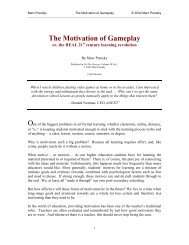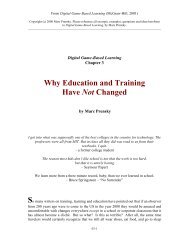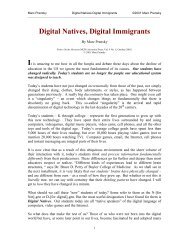Really Good News About Your Children's Video ... - Marc Prensky
Really Good News About Your Children's Video ... - Marc Prensky
Really Good News About Your Children's Video ... - Marc Prensky
Create successful ePaper yourself
Turn your PDF publications into a flip-book with our unique Google optimized e-Paper software.
<strong>Marc</strong> <strong>Prensky</strong> <strong>Really</strong> <strong>Good</strong> <strong>News</strong> <strong>About</strong> <strong>Your</strong> Children’s <strong>Video</strong> Games © 2003 <strong>Marc</strong> <strong>Prensky</strong><br />
_____________________________________________________________________________<br />
<strong>Really</strong> <strong>Good</strong> <strong>News</strong><br />
<strong>About</strong> <strong>Your</strong> Children’s <strong>Video</strong> Games<br />
by <strong>Marc</strong> <strong>Prensky</strong><br />
June 15, 2003<br />
Research published by University of Rochester neuroscientists C. Shawn Green and Daphne<br />
Bavelier has grabbed national attention for suggesting that playing “action” video and computer<br />
games has positive effects – enhancing student’s visual selective attention. But that finding is just<br />
one small part of a more important message that all parents and educators need to hear: video games<br />
are not the enemy, but the best opportunity we have to engage our kids in real learning.<br />
Any observer knows that the attitude of today’s children to video and computer games is the very<br />
opposite of the attitude that most of them have toward school. The amount of time they spend playing<br />
computer and video games – estimated at 10,000 hours by the time they are twenty-one, often in<br />
multi-hour bursts – belies the “short attention span” criticism of educators. And while years ago the<br />
group attracted to video and computer games was almost entirely adolescent boys, it is now<br />
increasingly girls and all children of all ages and social groups. One would be hard-pressed today to<br />
find a kid in America who doesn’t play computer or video games of one sort or another.<br />
The evidence is quickly mounting that our “Digital Native” children’s brains are changing to<br />
accommodate these new technologies with which they spend so much time. Not only are they better<br />
at spreading their attention over a wide range of events, as Green and Bavelier report, but they are<br />
better at parallel processing, taking in information more quickly (at “twitchspeed”), understanding<br />
multimedia, and collaborating over networks.<br />
What attracts and “glues” kids to today’s video and computer games is neither the violence, or even<br />
the surface subject matter, but rather the learning the games provide. Kids, like and all humans, love<br />
to learn when it isn’t forced on them. Modern computer and video games provide learning<br />
opportunities every second, or fraction thereof.<br />
On the surface, kids learn to do things – to fly airplanes, to drive fast cars, to be theme park operators,<br />
war fighters, civilization builders and veterinarians. But on deeper levels they learn infinitely more: to<br />
take in information from many sources and make decisions quickly; to deduce a game’s rules from<br />
playing rather than by being told; to create strategies for overcoming obstacles; to understand complex<br />
systems through experimentation. And, increasingly, they learn to collaborate with others. Many<br />
adults are not aware that games have long ago passed out of the single-player isolation shell imposed<br />
by lack of networking, and have gone back to being the social medium they have always been – on a<br />
worldwide scale. Massively Multiplayer games such as EverQuest now have hundreds of thousands<br />
of people playing simultaneously, collaborating nightly in clans and guilds.<br />
Today’s game-playing kid enters the first grade able to do and understand so many complex things –<br />
from building, to flying, to reasoning – that the curriculum they are given feel like they are being
<strong>Marc</strong> <strong>Prensky</strong> <strong>Really</strong> <strong>Good</strong> <strong>News</strong> <strong>About</strong> <strong>Your</strong> Children’s <strong>Video</strong> Games © 2003 <strong>Marc</strong> <strong>Prensky</strong><br />
_____________________________________________________________________________<br />
handed depressants. And it gets worse as the students progress. Their “Digital Immigrant” teachers<br />
know so little about the digital world of their charges – from online gaming to exchanging, sharing,<br />
meeting, evaluating, coordinating, programming, searching, customizing and socializing, that it is<br />
often impossible for them to design learning in the language and speed their students need and relish,<br />
despite their best efforts.<br />
An emerging coalition of academics, writers, foundations, game designers, companies like Microsoft<br />
and, increasingly, the U.S. Military is working to make parents and educators aware of the enormous<br />
potential for learning contained in the gaming medium. While “edutainment,” may work for preschoolers,<br />
it is primitive when it comes to the enormous sophistication of today’s games. We need<br />
new and better learning games, and these are finally beginning to appear. Microsoft has sponsored a<br />
“Games-to-Teach” project at MIT which is building games for learning difficult concepts in physics<br />
and environmental science on the X-Box and Pocket PC. Lucas Games has lesson plans to help<br />
teachers integrate its games into curricula to teach critical thinking. A UK study by TEEM (Teachers<br />
Evaluating Educational Multimedia) has shown that certain games can help youngsters to learn logical<br />
thinking and computer literacy. Given the almost perfect overlap between the profiles of gamers and<br />
military recruits, the US Military uses over 50 different video and computer games to teach everything<br />
from doctrine, to strategy and tactics. “America’s Army, Operations,” a recruiting game released for<br />
free in 2002, now has almost 2 million registered users, with almost a million having completed<br />
virtual basic training.<br />
Academic research into the positive effects of games on learning, which not so long ago sat unread on<br />
the shelf, is being noticed by national media. Theoretical and practical guides such as “What <strong>Video</strong><br />
Games Have To Teach Us <strong>About</strong> Learning And Literacy” by Professor of Education James Paul Gee,<br />
and my own “Digital Game-Based Learning,” are now on bookshelves. Experts, such as former<br />
Stanford CFO William Massey, who created the learning game “Virtual U.” are working with game<br />
designers to build games that communicate their knowledge and experience. Foundations like Sloan,<br />
Markle and others are funding these efforts. The Woodrow Wilson school has begun a project called<br />
“Serious Games” to increase the use of gaming in public policy debates, picking up an effort that<br />
begin 10 years ago with “Sim Health” from Maxis.<br />
Yet despite all the findings, research, and cries for help from the kids in school, many parents and<br />
educators still tend to think of video and computer games as frivolous at best and harmful at worst.<br />
The press often encourages this with headlines about “killing games” when in fact two thirds of the<br />
games are rated “E (everybody),” and sixteen of the top 20 sellers are rated either “E” or “T (teen)”.<br />
To counteract this “name prejudice,” users and funders of today’s “new” educational games often<br />
refer to them by “code” names, such as “Desktop Simulators,” “Synthetic Environments,” or<br />
“Immersive Interactive Experiences.”<br />
Yet what these new, highly effective learning tools really are a combination of the most compelling<br />
and interactive design elements of the best video and computer games with specific curricular content.<br />
The tricky part is doing this in ways that capture, rather than lose, the learner’s interest and attention.<br />
We are now becoming much better at this. The money and will is there to do it, and our students are<br />
crying for it.<br />
<strong>Marc</strong> <strong>Prensky</strong> is an internationally acclaimed thought leader, speaker, writer, consultant, and game<br />
designer in the critical areas of education and learning. He is the author of Digital Game-Based Learning<br />
(McGraw-Hill, 2001), founder and CEO of Games2train, a game-based learning company, and founder of<br />
The Digital Multiplier, an organization dedicated to eliminating the digital divide in learning worldwide.<br />
He is also the creator of the sites , <br />
and . <strong>Marc</strong> holds an MBA from Harvard and a Masters in Teaching<br />
from Yale. More of his writings can be found at . Contact<br />
<strong>Marc</strong> at marc@games2train.com.










